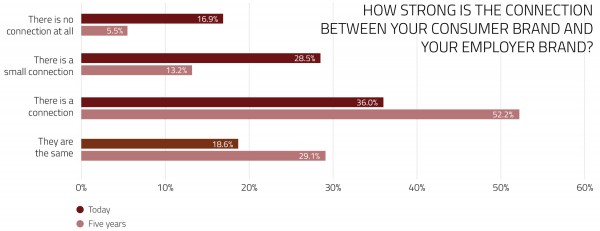The Power of a Unified Brand

Why Brand Alignment Is Growing in Importance

The growing necessity of brand alignment is leading to increasing awareness for CEOs, HR marketing executives, and C-level staff about expanding branding beyond simply selling products and services. Branding should also encompass a company’s culture, meet customer and employee expectations, and be promoted internally and externally.
The Hard Data on Brand Alignment, and What It Means

Although there is growing recognition of the importance of brand alignment, only19 percent of CEOs and other executivesindicate that their employer and consumer branding are one and the same. That being said, there is a desire to move towards a unified brand objective. In fact, nearly 30 percent of CEOs and other executives indicate they want these two branding concepts to be unified within five years. At the very least, many of them indicate that there is a clear connection between the two areas of branding, and more than half indicate they want a connection between the two in five years’ time.
On the other hand, marketers are far more sensitive to this alignment, with 82 percent indicating that there is either a connection between employer and consumer branding or employer and consumer branding are in fact one in the same, compared to only 55 percent of respondents in general. Sixty percent of marketers say that consumer branding is also taken into consideration when working on employer branding. In comparison, only 33 percent of general respondents said such a consideration was made.
(Note: All stats taken from Universum’s “Future of Employer Branding” study, linked in the first paragraph of this article.)
How Brand Alignment Can Attract Top Talent
One of the main priorities for companies now and in the future will be attracting top talent in the job market that can respond rapidly to changing consumer demands. These people will generate the game-changing ideas that every company needs to grow. Currently, 63 percent of CEOs are concerned about the availability of key skills, underlining the challenge that lies ahead, according to Universum’s study.
The fact is that brand alignment can help companies and HR departments find the right employees while meeting consumer demands at the same time. Working towards crafting a unified brand helps increase ROI for marketing activities by creating a different mindset within a company. This mindset helps focus marketing in a way that appeals to a broader audience, which simultaneously helps companies attract better talent and meet consumer demands.
Brand alignment offers a way to bridge the gap that often exists between employer and consumer branding. The next five years will be key for many companies. Data indicates that those companies with the strongest commitment to aligning consumer and employee branding will be rewarded with strong growth and higher shareholder value.

